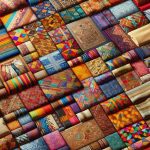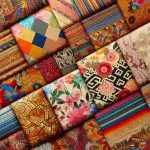Are you looking for the perfect silk fabric for your next formal event? Look no further!
This guide will provide you with all the information you need to find reliable silk fabrics that will make you stand out in any formal attire.
From the history of silk in formal wear to tips on care and maintenance, we’ve got you covered.
Get ready to shine in your silk outfit and make a lasting impression.
Table of Contents
The History of Silk in Formal Attire
Silk has played a significant role in formal attire throughout history. Its influence on fashion and cultural significance in formal attire can’t be overstated.
From ancient civilizations to modern times, silk has been a symbol of luxury and elegance.
The influence of silk on fashion can be traced back to ancient China, where it was first discovered. The Chinese perfected the art of silk production and soon it became highly sought after by the elite. Silk garments were reserved for special occasions and were a symbol of wealth and status. As trade routes expanded, silk made its way to other parts of the world, influencing fashion trends across different cultures.
In Western fashion, silk became popular during the Renaissance period. Royalty and nobility adorned themselves in silk fabrics, using them to showcase their wealth and power. Silk gowns and suits became synonymous with high society events and formal occasions.
The cultural significance of silk in formal attire goes beyond its aesthetic appeal. It represents tradition, history, and craftsmanship. Silk fabrics are known for their lustrous appearance and smooth texture, making them the perfect choice for formal wear. Whether it’s a silk tie, a silk dress, or a silk pocket square, incorporating silk into your formal attire adds an element of sophistication and refinement.
Types of Silk Fabrics for Formal Wear
When it comes to selecting silk fabrics for formal wear, it’s important to consider the common silk weaves, the best silk for suits, and the ideal silk for evening gowns. Understanding these different types of silk fabrics will help you make informed decisions for your formal attire.
Common Silk Weaves
You can explore various common silk weaves that are ideal for formal wear. These silk weaves aren’t only luxurious but also add a touch of elegance to any outfit. Here are three popular silk patterns that you can consider for your formal attire:
-
Plain Weave: This is the simplest and most common silk weave, known for its smooth and shiny appearance. It has a tight and uniform structure, making it suitable for both casual and formal occasions.
-
Jacquard Weave: This intricate weave creates beautiful patterns and designs on the fabric. It adds texture and visual interest to your formal outfit, making it stand out from the crowd.
-
Brocade Weave: This weave features raised patterns that are woven into the fabric. It gives a rich and opulent look, perfect for formal events or special occasions.
Best Silk for Suits
For formal wear, the ideal silk fabrics for suits include a variety of options. When it comes to silk for ties, the most popular choice is silk twill. Silk twill is known for its durability and elegant drape, making it perfect for creating sleek and sophisticated ties.
Another great option for suits is silk for tuxedos. Silk satin is often used for tuxedos due to its luxurious and lustrous appearance. It has a smooth and shiny surface that adds a touch of glamour to any formal ensemble.
Other types of silk, such as silk jacquard and silk brocade, can also be used for suits, depending on the desired style and occasion.
When choosing silk fabrics for suits, consider the level of formality and the overall aesthetic you want to achieve.
Silk for Evening Gowns
To create stunning evening gowns, consider incorporating different types of silk fabrics that exude elegance and sophistication. Silk is a luxurious fabric that’s often used for formal wear due to its exceptional properties.
Here are three types of silk fabrics commonly used for evening gowns:
-
Charmeuse: This lightweight silk fabric has a glossy finish and a soft drape, making it perfect for flowing and elegant evening gowns. It’s known for its smooth texture and subtle sheen.
-
Dupioni: This textured silk fabric is characterized by its irregular, slubby appearance. It adds visual interest and depth to evening gowns, making them stand out. Dupioni silk is also known for its durability and resistance to wrinkles.
-
Chiffon: This sheer and lightweight silk fabric is often used for layering or creating delicate overlays on evening gowns. Its ethereal quality adds a touch of romance and femininity to any design.
When it comes to dyeing silk fabrics for evening gowns, various techniques can be used, including hand painting, dip dyeing, and tie-dyeing. These techniques allow for unique and vibrant color variations that enhance the overall design of the gown.
Factors to Consider When Choosing Silk for Formal Attire
When selecting silk for formal attire, considering the fabric’s durability is essential. Silk is a luxurious and elegant choice for weddings and other formal occasions, but not all silk fabrics are created equal. Here are some factors to consider when choosing silk for your formal attire:
| Factor | Description |
|---|---|
| Weight | The weight of the silk fabric is important as it can affect the drape and flow of the garment. Lighter silks like chiffon or charmeuse are perfect for flowing dresses, while heavier silks like satin or brocade provide structure and elegance. |
| Finish | The finish of the silk fabric can greatly impact its appearance. Matte silk has a soft, understated look, while shiny silk like satin adds a touch of glamour. Consider the overall aesthetic you want to achieve when choosing the finish of your silk fabric. |
| Weave | The weave of silk can affect its texture and durability. Look for tightly woven silk fabrics like crepe de chine or organza for a smooth and durable fabric. Avoid delicate weaves like habotai silk, as they may be prone to tearing. |
Care and Maintenance of Silk Fabrics
Taking care of your silk fabrics is crucial to maintain their quality and appearance.
To wash silk properly, always use a gentle detergent and cold water, avoiding any harsh rubbing or twisting.
Additionally, it’s important to know how to remove stains from silk using appropriate stain removers and techniques.
Lastly, preventing silk wrinkles can be achieved by storing your silk garments properly and avoiding excessive folding or hanging in direct sunlight.
Washing Silk Properly
For proper care and maintenance of silk fabrics, it’s essential to follow the instructions for washing silk with a gentle hand wash using a mild detergent.
Here are three important steps to ensure you wash your silk properly:
-
Fill a basin or sink with lukewarm water and add a small amount of mild detergent specifically made for delicate fabrics.
-
Gently agitate the water to create suds and immerse the silk garment, making sure it’s fully submerged.
-
Swish the garment around in the soapy water for a few minutes, being careful not to rub or scrub it vigorously. Then, rinse the silk thoroughly with cold water to remove all traces of detergent.
Removing Stains From Silk
To effectively maintain and care for your silk fabrics, it’s important to know how to remove stains from silk without causing damage. When dealing with stains on silk, it’s crucial to act quickly.
First, gently blot the stain with a clean, white cloth to remove any excess liquid. Avoid rubbing, as it can spread the stain and damage the fabric.
Next, use a mild detergent or a specialized silk cleaner to treat the stain. Apply a small amount to the affected area and gently work it into the fabric using a soft cloth.
Rinse the area thoroughly with cold water and pat it dry with a clean towel.
Remember to always test any cleaning solution on a small, inconspicuous area of the fabric first to prevent color fading on silk.
Preventing Silk Wrinkles
To prevent wrinkles in your silk fabrics, it’s important to properly care for and maintain them. Here are three key tips to help you keep your silk wrinkle-free:
-
Handwashing: Gently handwash your silk garments using a mild detergent and cold water. Avoid using bleach or harsh chemicals, as they can damage the fabric and lead to wrinkles.
-
Air drying: After washing, lay your silk garments flat on a clean towel to air dry. Avoid wringing or twisting the fabric, as this can cause wrinkles. Hang drying can also result in stretching and distortion of the garment’s shape.
-
Silk ironing techniques: When ironing silk, set your iron to a low temperature or use the silk setting. Place a clean, damp cloth between the iron and the fabric to protect it from direct heat. Iron in gentle, straight strokes, and avoid pressing too hard to prevent wrinkles.
Styling Tips for Formal Silk Outfits
When styling formal silk outfits, incorporate statement accessories to elevate your overall look. Styling tips for formal silk outfits involve choosing the right accessories that complement your outfit and add a touch of sophistication.
To begin, opt for a statement necklace or a pair of elegant earrings to draw attention to your face and add a touch of glamour. Consider the neckline of your outfit when selecting a necklace – a plunging neckline pairs well with a long pendant, while a high neckline looks stunning with a choker.
Additionally, a silk scarf can be a versatile accessory that adds a pop of color and can be worn in multiple ways, such as tied around your neck or draped over your shoulders. For a more formal touch, add a sleek belt to cinch in your waist and enhance your silhouette.
Lastly, don’t forget about your handbag – opt for a small clutch or a structured handbag in a complementary color to complete your polished look. By choosing the right accessories, you can effortlessly elevate your formal silk outfit and make a memorable impression.
Where to Buy Quality Silk Fabrics for Formal Attire
If you’re looking for high-quality silk fabrics for formal attire, a reliable option is to explore specialty fabric stores in your area. These stores often carry a wide selection of silk fabrics specifically designed for formal wear, ensuring that you can find the perfect fabric for your needs.
Here are three advantages of silk over other fabrics for formal attire:
-
Luxurious feel: Silk is known for its smooth and soft texture, which adds a touch of luxury to any formal outfit. When you wear silk, you’ll feel elegant and sophisticated, making it the ideal choice for special occasions.
-
Breathability: Unlike synthetic fabrics, silk is a natural material that allows your skin to breathe. This is especially important for formal attire, as you want to feel comfortable throughout the event. Silk’s breathability helps regulate body temperature, keeping you cool in warm weather and warm in cooler temperatures.
-
Timeless elegance: Silk has been used in formal wear for centuries, and it continues to be a timeless choice for its elegance and versatility. Whether you’re attending a black-tie event or a wedding, silk fabrics will always exude sophistication and class.
When buying silk fabrics for formal attire, it’s important to avoid certain places. Be cautious of online sellers with dubious reviews or questionable origins of their products. Additionally, avoid purchasing silk fabrics from regular clothing stores, as their selection may not be as extensive or specialized as a specialty fabric store.
Frequently Asked Questions
How Do I Know if a Silk Fabric Is Reliable and of Good Quality?
To know if silk fabric is reliable and of good quality, you can check for a few things. Look for a smooth texture, strong and even threads, and a reputable brand or seller. Don’t forget to consider customer reviews too!
Can Silk Fabrics Be Altered or Tailored to Fit Perfectly for Formal Attire?
Yes, silk fabrics can be altered or tailored to fit perfectly for formal attire. With the right skills and expertise, a skilled tailor can make adjustments to ensure your silk garment looks and feels great.
Are There Any Specific Guidelines for Storing Silk Garments to Maintain Their Quality and Longevity?
To maintain the quality and longevity of your silk garments, follow these tips for storing: keep them in a cool, dry place; avoid exposure to direct sunlight; and store them folded or wrapped in acid-free tissue paper.
What Are Some Common Mistakes People Make When Caring for Silk Fabrics?
Common mistakes when caring for silk fabrics include using harsh detergents, machine washing, and scrubbing vigorously. To care for silk, follow these tips: hand wash with a gentle detergent, air dry, and avoid direct sunlight.
Are There Any Alternative Fabrics That Can Be Used for Formal Attire if Silk Is Not an Option?
If silk isn’t an option for formal attire, there are alternative fabrics to consider. These fabrics have their pros and cons, so it’s important to do your research and choose the best option for your needs.
- Innovations in Moisture-Wicking Textiles - July 18, 2024
- Engineering Fabrics for Optimal Performance - July 18, 2024
- The Science of Breathability in Fabrics - July 18, 2024





